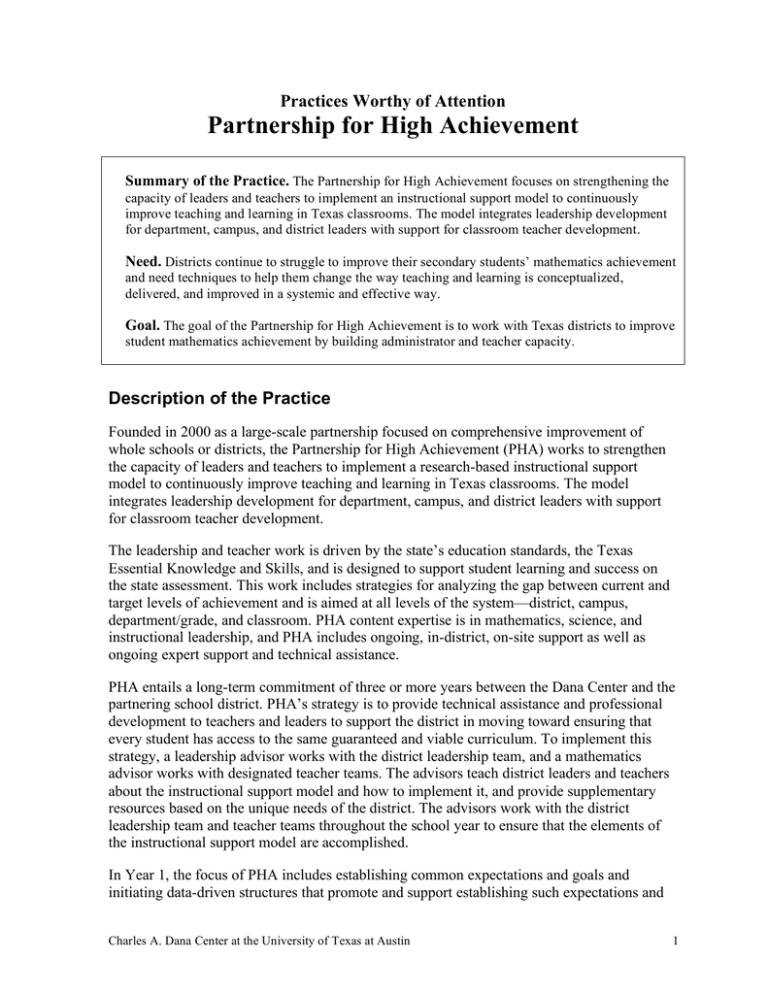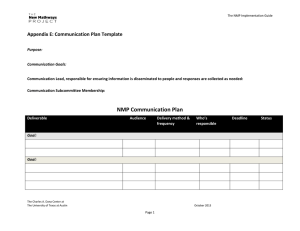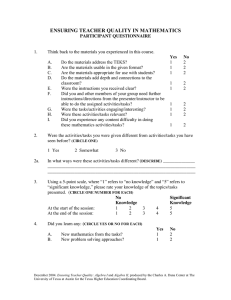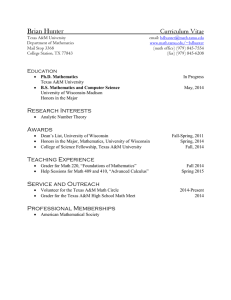Partnership for High Achievement Practices Worthy of Attention Summary of the Practice.
advertisement

Practices Worthy of Attention Partnership for High Achievement Summary of the Practice. The Partnership for High Achievement focuses on strengthening the capacity of leaders and teachers to implement an instructional support model to continuously improve teaching and learning in Texas classrooms. The model integrates leadership development for department, campus, and district leaders with support for classroom teacher development. Need. Districts continue to struggle to improve their secondary students’ mathematics achievement and need techniques to help them change the way teaching and learning is conceptualized, delivered, and improved in a systemic and effective way. Goal. The goal of the Partnership for High Achievement is to work with Texas districts to improve student mathematics achievement by building administrator and teacher capacity. Description of the Practice Founded in 2000 as a large-scale partnership focused on comprehensive improvement of whole schools or districts, the Partnership for High Achievement (PHA) works to strengthen the capacity of leaders and teachers to implement a research-based instructional support model to continuously improve teaching and learning in Texas classrooms. The model integrates leadership development for department, campus, and district leaders with support for classroom teacher development. The leadership and teacher work is driven by the state’s education standards, the Texas Essential Knowledge and Skills, and is designed to support student learning and success on the state assessment. This work includes strategies for analyzing the gap between current and target levels of achievement and is aimed at all levels of the system—district, campus, department/grade, and classroom. PHA content expertise is in mathematics, science, and instructional leadership, and PHA includes ongoing, in-district, on-site support as well as ongoing expert support and technical assistance. PHA entails a long-term commitment of three or more years between the Dana Center and the partnering school district. PHA’s strategy is to provide technical assistance and professional development to teachers and leaders to support the district in moving toward ensuring that every student has access to the same guaranteed and viable curriculum. To implement this strategy, a leadership advisor works with the district leadership team, and a mathematics advisor works with designated teacher teams. The advisors teach district leaders and teachers about the instructional support model and how to implement it, and provide supplementary resources based on the unique needs of the district. The advisors work with the district leadership team and teacher teams throughout the school year to ensure that the elements of the instructional support model are accomplished. In Year 1, the focus of PHA includes establishing common expectations and goals and initiating data-driven structures that promote and support establishing such expectations and Charles A. Dana Center at the University of Texas at Austin 1 Practices Worthy of Attention Partnership for High Achievement goals, through implementation of a guaranteed and viable curriculum, teacher–leader collaboration, and the use of research- and practice-tested methods to improve student learning. In Year 2, the focus of PHA is on refining and reinforcing the work from Year 1, strengthening and expanding data-driven structures and actions, and developing support structures for multilevel monitoring of curriculum, instruction, and student learning. In Year 3, the focus is on expanding the work of Years 1 and 2, monitoring and refining multilevel support structures, and continuing examination of research- and practice-tested methods. Throughout all three years of work, PHA advisors help district leaders and teachers build goals and then provide concrete structures to help them meet these goals. There are two separate sets of expectations and processes for district leaders and teachers. For the district leaders, there are four main expectations: make expectations clear, build capacity, monitor and act, and establish mutual accountability. PHA helps provide the necessary support to carry out these expectations, through • ensuring access to the guaranteed and viable curriculum, • providing access to aligned resources, • building structures for ongoing collaboration, • encouraging the formation of professional learning opportunities, and • offering supportive feedback and intervention when necessary. For teachers, there are also four expectations: accept responsibility for student learning, implement a guaranteed and viable curriculum, collaborate with colleagues, and continuously improve practice. PHA provides teachers the support they need to carry out these expectations by teaching them to • provide students with access to the guaranteed and viable curriculum, • ensure classroom resources are aligned, • use provided structures for collaboration, • access professional learning opportunities, and • receive supportive feedback and intervention when necessary. PHA developed the expectations and support after a careful review of research on systemic change and teacher education and professional development. PHA work assumes that professionals are interactive learners who benefit from structured, focused conversation to develop a common understanding of purpose and to learn from one another. The structure for such interaction is best seen in professional learning communities, where teachers’ professional development involves collective participation over time (Corcoran, McVay, & Riordan, 2003; Darling-Hammond & Sykes, 1999; DuFour & Eaker, 1998; Halverson, 2004; Charles A. Dana Center at the University of Texas at Austin 2 Practices Worthy of Attention Partnership for High Achievement Printy & Marks, 2004). Professional learning communities provide a local forum, sensitive to the specific needs of the teachers in a school or district. While a professional learning community is a great place for teacher collegiality, the focus of the meetings must be on substantive teaching and learning needs for teachers to benefit professionally from the interactions. Discussion about standards, assessment, student work, and reflective practice is a key component in effective professional learning communities, where teachers can apply specific techniques and strategies to their classrooms, reflect on their past lessons, and strategize what they can and will do to modify future instruction (Black & Wiliam, 1998; Elmore, 2000; York-Barr, Sommers, Ghere, & Montie, 2006; Zeichner & Liston, 1996). In fact, if discussions specific to the content needs of teachers are conducted, professional learning is all the more effective (Loucks-Horsley et al., 2003). To attain wide-scale systemic change, expectations and support must focus on more than individual actions or stand-alone interventions. Elements of systemic reform include establishing new professional cultures and having teacher buy-in for implementing new ideas for school or district improvement (Cohen, 1995; Elmore, 2000; Ferriter & Norton, 2004; Hall & Hord, 2001; Heck & Hallinger, 1999; Johnson, Skrla, & Scheurich, 2000; Kanter, 1999; Leithwood & Jantzi, 2000). The PHA process protocols incorporate principles of change and lessons from successful school change models to provide the support that teachers and leaders need to drive change in their education system. A guaranteed and viable curriculum, as defined by Marzano (2003), is a standards-based and realistically implementable curriculum that is guaranteed to address the learning needs of all students in an education system. A careful walkthrough of documentation and close reading for understanding of the use of such documents is important for improved professional learning, for administrators as well as for teachers (Bloom, 1956; Bottoms, 2001; Bryk, Newman, Smith, & Allensworth, 2001; National Council of Teachers of Mathematics, 2000; Porter, 2001). The application of objectives and standards to district-required curriculum also requires some practice, helping teachers better learn the mathematics associated with certain lessons (Bottoms, 2001; Porter, Smithson, Osthoff, 1994; Spillane, 2005; Yañez & Wenrick, 2000), specifically with strategies for improving instructional practice and attending to a diverse set of student needs (Banks et al., 2001; Marzano, 2003; Matsumura, 2003). Lastly, structures for monitoring and feedback must be in place to support continued professional learning within the education system. For instance, assessment should be seen as a tool that should inform both student learning and teacher practices, and monitoring student learning should be an embedded classroom activity that is systematically and continuously included in classroom procedures (Black & Wiliam, 1998; Schmoker, 1999, 2001, 2006; Stiggins, 2002; York-Barr et al., 2006). At the core of PHA is the professional teaching model (PTM). PTM frames the way teachers and administrators set and achieve goals. After a goal is set, the PTM process includes six steps: study, determine, plan, implement, analyze, and review and revise. In one of the first meetings, attendees are asked to identify a set of goals, and the PTM process is applied directly to these goals throughout the year, with the guidance of a PHA facilitator. The PTM process is a concrete way for teachers and administrators to collaboratively develop and Charles A. Dana Center at the University of Texas at Austin 3 Practices Worthy of Attention Partnership for High Achievement implement a common lesson that produces common student work, develop the knowledge and skills necessary to consistently and accurately identify evidence of criteria in student work, and understand how to use student work as a data source to identify instructional and programmatic strengths and weaknesses. Results Where the PHA leadership and teacher protocols have been implemented with fidelity, there is strong evidence that shows student performance gains outpacing statewide performance over a two- to three-year period. For 2003 through 2006, participating districts’ mathematics and science scores went from below the state average to above the state average. In addition, for the 14 participating high schools in Houston Independent School District, the passing rates on the Texas Assessment of Knowledge and Skills (TAKS) for ninth- through eleventh-grade mathematics increased 21% from 2004 to 2006, compared to a statewide increase of 14%. Table 1 lists the percentage of students in participating schools in HISD passing the mathematics TAKS in grades 6–11 by race/ethnicity, limited English proficiency, and economic disadvantage. The fact that the participating Houston schools have a steady increase shows promise for the intervention of PHA in improving administrator and teacher practice, which may be translating to student improvement in mathematics. Table 1. Houston Independent School District Results on the Texas Assessment of Knowledge and Skills Mathematics Exam Demographics All Students Asian American Black Hispanic Academic Year Percentage Meeting Standard by Grade Level 6 7 8 9 10 11 2002–2003 54 47 50 38 48 62 2003–2004 62 58 57 45 51 80 2004–2005 56 48 48 45 44 60 2005–2006 65 59 59 45 51 71 2002–2003 86 81 83 78 85 89 2003–2004 90 86 85 83 87 94 2004–2005 90 87 82 80 84 89 2005–2006 93 91 90 80 87 94 2002–2003 45 40 43 30 41 53 2003–2004 53 48 49 30 38 76 2004–2005 46 38 40 35 33 49 2005–2006 56 51 50 34 40 64 2002–2003 53 42 46 34 42 56 2003–2004 61 56 55 41 48 77 2004–2005 55 45 45 41 39 55 2005–2006 64 57 57 41 47 66 Charles A. Dana Center at the University of Texas at Austin 4 Practices Worthy of Attention Partnership for High Achievement Table 1, continued Demographics White Limited English Proficient Economically Disadvantaged Academic Year Percentage Meeting Standard by Grade Level 6 7 8 9 10 11 2002–2003 82 80 81 72 79 85 2003–2004 90 86 85 82 81 95 2004–2005 87 84 82 77 80 86 2005–2006 91 90 85 81 80 91 2002–2003 31 15 16 12 21 30 2003–2004 38 26 24 15 22 54 2004–2005 32 16 18 12 10 26 2005–2006 41 27 23 16 19 35 2002–2003 49 40 41 32 41 55 2003–2004 58 52 51 39 44 75 2004–2005 51 42 42 38 36 54 2005–2006 61 54 54 38 45 65 The Partnership for High Achievement project shows some compelling results in improving students’ mathematics achievement. However, no studies have yet been conducted to better understand the different levels of implementation, the changes made to teacher and district leaders’ practices, and the relationship of those changes to student mathematics achievement. These types of studies are beginning with both internal and external evaluators. References Banks, J., Cookson, P., Gay, G., Hawley, W. D., Irvine, J. J., Nieto, S., & Stephan, W. G. (2001). Diversity within unity: Essential principles for teaching and learning in a multicultural society. Seattle: Center for Multicultural Education, College of Education, University of Washington. Black, P., & Wiliam, D. (1998). Inside the black box: Raising standards through classroom assessment. Phi Delta Kappan, 80(2), 139-148. Bloom, B. S. (Ed.). (1956). Taxonomy of educational objectives: The classification of educational goals. Vol. 1, Cognitive domain. White Plains, NY: Longman. Reissued by Pearson Education, 1984. Bottoms, G. (2001). What school principals need to know about curriculum and instruction. Atlanta: Southern Regional Education Board. Charles A. Dana Center at the University of Texas at Austin 5 Practices Worthy of Attention Partnership for High Achievement Bryk, A., Newman, F., Smith, B., & Allensworth, E. (2001). Instructional program coherence: What it is and why it should guide school improvement policy? Educational Evaluation and Policy Analysis, 23(4), 297-321. Corcoran, T., McVay, S., & Riordan, K. (2003). Getting it right: The MISE approach to professional development. Philadelphia: Consortium for Policy Research in Education. Cohen, D. K. (1995). What is the system in systemic reform? Educational Researcher, 24(9), 11-17, 31. Darling-Hammond, L., & Sykes, G. (Eds.). (1999). Teaching as the learning profession. San Francisco: Jossey-Bass. DuFour, R., & Eaker, R. (1998). Professional learning communities at work: Best practices for enhancing student achievement. Bloomington, IN: National Educational Service. Elmore, R. F. (2000). Building a new structure for school leadership. Washington, DC: Albert Shanker Institute. Ferriter, W., & Norton, J. (2004, Spring). Creating a culture of excellence. Threshold, 18-21. Hall, G., & Hord, S. (2001). Implementing change: Patterns, principles, and potholes. Needham Heights, MA: Allyn and Bacon. Halverson, R. (2004). Accessing, documenting, and communicating practical wisdom: The phronesis of school leadership practice. American Journal of Education, 111, 90-121. Heck, R. H., & Hallinger, P. (Eds.). (1999). Next generation methods for the study of leadership and school improvement. San Francisco: Jossey-Bass. Johnson, J., Skrla, L., & Scheurich, J. (2000). Equity-driven, achievement-focused school districts: A report on systemic school success in four Texas school districts serving diverse student populations. Austin, TX: Charles A. Dana Center, The University of Texas at Austin. Kanter, R. M. (1999). The enduring skills of change leaders. Leader to Leader, 13, 15-22. Leithwood, K. A., & Jantzi, D. (2000). The effects of transformational leadership on organizational conditions and student engagement with school. Journal of Educational Administration, 38(2), 112-129. Loucks-Horsley, S., Love, N., Stiles, K. E., Mundry, S., & Hewson, P. W. (2003). Designing professional development for teachers of science and mathematics (2nd ed.). Thousand Oaks, CA: Corwin Press. Marzano, R. J. (2003). What works in schools: Translating research into action. Alexandria, VA: Association for Supervision and Curriculum Development. Charles A. Dana Center at the University of Texas at Austin 6 Practices Worthy of Attention Partnership for High Achievement Matsumura, L. C. (2003). Teachers’ assignments and student work: Opening a window on classroom practice. Los Angeles: Center for the Study of Evaluation, National Center for Research on Evaluation, Standards, and Student Testing (NCRESST), University of California. National Council of Teachers of Mathematics. (2000). Principles and standards for school mathematics. Reston, VA: Author. Porter, A. C. (2001). Defining, developing, and using curriculum indicators. Philadelphia: Consortium for Policy Research in Education. Porter, A. C., Smithson, J., & Osthoff, E. (1994). Reform of high school mathematics and science and opportunity to learn. CPRE Policy Briefs. Philadelphia: Consortium for Policy Research in Education. Printy, S. M., & Marks, H. M. (2004). Communities of practice and teacher quality. In W. K. Hoy & C. G. Miskel (Eds.), Educational administration, policy, and reform: Research and measurement. Vol. 3 in Research and Theory in Educational Administration. Greenwich, CT: Information Age Publishing. Schmoker, M. (1999). Results: The key to continuous school improvement. Alexandria, VA: Association for Supervision and Curriculum Development. Schmoker, M. (2001). The results fieldbook: Practical strategies from dramatically improved schools. Alexandria, VA: Association for Supervision and Curriculum Development. Schmoker, M. (2006). Results now: How we can achieve unprecedented improvements in teaching and learning. Alexandria, VA: Association for Supervision and Curriculum Development. Stiggins, R. (2002). Assessment crisis: The absence of assessment for learning. Phi Delta Kappan, 83(10), 758–765. Spillane, J. P. (2005). Primary school leadership practice: How the subject matters. School Leadership and Management, 25(4), 383–397. Yañez, D., & Wenrick, M. (2000). Improving Algebra I End-of-Course Exam scores: Evidence from the field. Austin, TX: Charles A. Dana Center, The University of Texas at Austin. York-Barr, J., Sommers, W. A., Ghere, G. S., & Montie, J. (2006). Reflective practice to improve schools: An action guide for educators (2nd ed.). Thousand Oaks, CA: Corwin Press. Zeichner, K. M., & Liston, D. P. (1996). Reflective teaching: An introduction. Mahwah, NJ: Erlbaum. Charles A. Dana Center at the University of Texas at Austin 7 Practices Worthy of Attention Partnership for High Achievement About Practices Worthy of Attention: Local Innovations in Strengthening Secondary Mathematics Practices Worthy of Attention is a joint initiative of Achieve, Inc. (www.achieve.org), and the Charles A. Dana Center at The University of Texas at Austin (www.utdanacenter.org). The initiative is led by Pamela L. Paek, a research associate at the Dana Center, who, in 2006, examined 22 program, school, and district practices that showed promise—based on early evidence and observation—of strengthening secondary mathematics teaching and learning. Our goal was to document practitioners’ descriptions of what is really happening in the field to strengthen secondary mathematics education around the country. Thus, while the practice highlighted may be common, the specific structures and strategies used to implement the practice are worthy of attention. These initial investigations set out to mark these practices for future rigorous scientific inquiry by Dana Center and other researchers. Ultimately, we hope to create a community of inquiry made up of university researchers working with administrators and teachers from featured schools and districts to more rigorously research how effectively these practices improve secondary mathematics learning for all students. Reports and practice profiles. An executive summary details the methods for this initiative and analyzes themes. Two cross-case analyses discuss specific strategies for raising student achievement and building teacher capacity. Brief profiles describe each practice. All of these publications are available on our website at www.utdanacenter.org. Data. In all cases, data about the practice were provided by the program, school, or district studied as part of a description of their practice. We did not independently analyze data gathered through a consistent assessment tool, and we did not evaluate their uses of data for measuring effectiveness. Thus, the data in the practice profiles are intended not to prove the practice’s effectiveness from a research perspective, but to paint a detailed picture of the practice and what data were used by the program, school, or district to gauge how well it was working. Theoretical frameworks. In some cases, district staff mentioned specific literature on theory or practice that they used when they developed the practice we highlight. In those cases, we cite that literature in our discussion of the practice. How to cite this profile Paek, P. L. (2008, January). Partnership for High Achievement. Case study from Practices worthy of attention: Local innovations in strengthening secondary mathematics. Austin, TX: Charles A. Dana Center at The University of Texas at Austin. Charles A. Dana Center at the University of Texas at Austin 8




